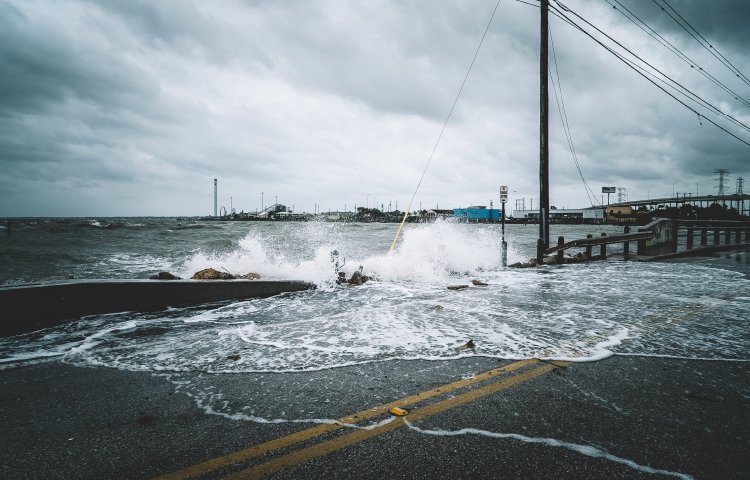Disasters – The devastation to society, the economy, and the courts

Katherine Smith Dedrick, JD MBA FCIArb
March, 2023
Both manmade (cyber, oil and waste spills, explosions) and natural disasters (fires, floods, hurricanes, earthquakes) are happening at an increasing pace in the US and around the world. These events have a direct impact on the bottom line of businesses and the ability of courts to resolve the resulting flood of litigation. As these incidents increase, so does the potential impact on society, the economy, and businesses, all of which must work to stay ahead of disaster curves and recover quickly from the aftermath. The courts, however, are limited by capacity and a system that often does not allow swift and economic resolution of disputes, especially those arising from disasters.
In 2022, there were 18 climate/weather disaster events in the US, with losses greater than $1 billion each. These events include flooding, wildfire, severe storms, winter storms and tropical cyclone events. It is estimated that about 43% of billion-dollar natural disaster events have occurred in the last decade.[1]
Recent disaster events outside of the US include Cyclone Gabrielle that hit the North Island of New Zealand in February of 2023. New Zealand entered a state of emergency with Prime Minister Chris Hipkins stating, “[t]he severity and the damage that we are seeing has not been experienced in a generation.” The economic impacts are just now being considered but estimated to be in the tens of billions of dollars. The 2023 Turkey-Syria earthquake is another.
The types of damages typically experienced from a disaster include bodily injury (including mental health and death), property damage (commercial, residential, auto), business interruption, extra expense (living expenses), contents (commercial, personal) and other (i.e. loss of market share, goodwill).
There are numerous examples of disasters which have caused a flood of litigation into courts:
New Zealand Earthquakes (2010 – 2011)
The Canterbury Earthquakes
- The South Island and specifically the town of Christchurch, experienced a series of earthquakes and devastating damage to commercial buildings, homes and livelihood. Losses have been estimated at around 38 billion in claim costs.[2]
- Twelve years after the anniversary of the February 2011 earthquake, it is estimated that more than 1,000 claims have not been resolved, (298 homeowner claims, 845 claims with the EQC (Earthquake Commission) and 59 in the courts). The results for another 23,000 homeowners depend on the results of a class action against EQC.[3]
- In 2019, to help with the resolution of claims, the Canterbury Earthquakes Insurance Tribunal was created to provide homeowners with a fair, fast and cost-effective way to resolve their claims with insurers and the EQC.
Hurricane Katrina – Delay in Evaluating Claims – Resulting in Class Action Litigation
Louisiana Citizens Insurance Company
- Class action against non-profit state-sponsored insurance company for alleged pattern and practice of failing to send adjusters to review claims within 30 days (as required by state law). State law did not require proof of bad faith conduct on part of insurer.
- $105M judgment (affirmed by U.S. Supreme Court) for approximately 18,500 claims.
- Remaining 80,000 claims settled for approximately $4,500 per claim, that they can show was delayed.
Superstorm Sandy
- Approximately 1,600 cases (separately consolidated in New York (NY) and NY federal courts).
- Primarily involved allegations that insurers of so called “write-your-own” flood insurance policies (backed by the Federal Emergency Management Agency (FEMA)) used engineering companies that underestimated damages to low-ball or deny claims.
- Claimants alleged that, after claims were estimated initially, the insurers had engineers conduct a “peer review” process.
- The process resulted in revised reports without consultation with original engineers.
- Revised reports generally concluded that the damages pre-dated the storm and were not compensable.
- Resulted in a FEMA claims review process (for non-litigants) and as of 2017, 89% of the claims were closed with over 14,500 homeowners receiving an additional $242.1M.[4]
Murphy Oil (Katrina)
- 27 consolidated class actions filed by residents of St. Bernard Parish.
- Allegations were that after Hurricane Katrina an oil tank that was dislodged from its moorings due to the flood waters, and discharged thousands of barrels of oil into the surrounding area.
- Plaintiffs were homeowners and residents in the area near the oil refinery who alleged property damage, personal injuries, and mental anguish resulting from the discharge. Turner v. Murphy Oil USA, Inc., 472 F. Supp. 2d 830 (2007).
- Defendant implemented a voluntary settlement program accepted by 2,700 (of 6,500) property owners, which reduced the size of the class.
- Settled for approximately $330M (including payments to property owners under class settlement and voluntary settlement program and general environmental clean-up).
- Understandably, natural and manmade disasters are among the top risks identified by companies around the world. The Allianz Risk Barometer report has identified the major business risks for 2023, as ranked by 2,712 risk management experts from 94 countries and territories, across 23 industry sectors. The respondents were from companies of all sizes and were questioned in October and November of 2022.
According to the Allianz Risk Barometer, businesses ranked natural catastrophes and climate change concerns as numbers 6 and 7 in their list of top 10 risks for 2023. The top 10 global business risks are:
- Cyber incidents
- Business interruption (including supply chain disruption)
- Macroeconomic developments (inflation, monetary policies, etc.)
- Energy crisis
- Regulatory and legislative changes
- Natural catastrophes (storm, flood, earthquake, wildfire, extreme water events)
- Climate change (physical, operational and financial risks due to global warming)
- Worker shortage
- Fire, explosion
- Political and violence.
Interestingly, these risks often impact one another. For instance, natural catastrophes and climate change can, and often do, impact business interruption (risk number 2) and worker shortage (risk number 8).
With the clear history of damages caused by an increasing number of disasters, coupled with the business and societal impact, it should come as no surprise that courts are typically inundated with an excessive number of claims after a disaster. These claims are added to what is often already a full caseload. According to a report cited by the American Arbitration Association, “[o]n average, U.S. district court cases took more than 12 months longer to get to trial than cases adjudicated by arbitration (24.2 months vs 11.6 months).”[5]
Disasters cause uncertainty in business, the economy and society. There is nothing markets, business and society like less than uncertainty. Accordingly, a different and nimble process is needed to respond to the aftermath of disasters. Many parties involved in post-disaster disputes may not have arbitration agreements in their contracts, and so remain stuck in the often slow court process. Instead, an arbitral process that parties can opt into after a disaster, even if the parties did not have an arbitration agreement prior to the disaster, would be an alternative to the years long wait for resolution provided by the courts. Such an opt-in process could involve offering different options of pre-set agreements that parties can accept or alter to fit their situation. Some of these pre-drafted agreements might provide for partial resolution of a dispute, as often one of the main hurdles to the resolution of business disputes is the inability to agree on the amount of damage (i.e. the cost to repair or replace a building, or the financial impact to a company (business interruption)). Once the damage issue is resolved, the remaining issues might be more easily resolve by settlement.
Many of the existing processes of different arbitral institutions might be incorporated into these opt-in agreements. In other words, the parties might choose between a single arbitrator or a panel, a set exchange of information, or even an expedited resolution. A specific list of neutrals to handle these disputes should be vetted and ready.
In conclusion, the proposed disaster arbitration resolution process should include having agreement options available for the parties to choose and agree on; neutrals, who are experienced in areas such as disaster resolution, claims and commercial contracts, vetted and on a roster; and the process ready to quickly proceed. Disasters are no longer once in a lifetime events. Certainly, final awards provided via arbitration will help move recovery forward and assist businesses, the economy and society.
About the author:
Katherine Smith Dedrick, JD MBA FCIArb specialises in risk management, disaster recovery, claim management, bad faith, insurance coverage and commercial disputes. She is immediate past chair of the Ciarb North America Branch, a neutral, managing member at her law firm, board member of a Mutual Fund, and co-founder of an international consulting company.
[1] National Centers for Environmental Information – Source: Billion-Dollar Weather and Climate Disasters. The National Oceanic and Atmospheric Administration calculates the costs of natural disasters. The calculation is considered conservative as it includes only 1) physical damage to homes, businesses and government buildings; 2) the cost of businesses being shut down or people losing their homes; and 3) damage to property inside the buildings. Many other costs are not included such as environmental damage, mental or physical healthcare costs or supply chain impact.
[2]Reserve Bank of New Zealand, Funding and Reserving Canterbury Earthquake Insurance Claims, Feb. 2021.
[3]Stuff, Quake-hit Cantabrians Still Mired in Claims 12 Years After Disaster, Feb. 22, 2023.
[4]PBS Frontline, Millions More Paid To Superstorm Sandy Victims After Fraud Claims, Nov. 8, 2017.
[5]Efficiency and Economic Benefits of Dispute Resolution through Arbitration Compared with U.S. District Court Proceedings by Roy Weinstein, Cullen Edes, Joe Hale and Nels Pearsall, Micronomics – Economic Research and Consulting March, 2017.



